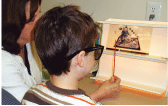 Q: What do the results of the Convergence Insufficiency Treatment Trial (CITT) tell us?
Q: What do the results of the Convergence Insufficiency Treatment Trial (CITT) tell us?
A:The 12-week study found that office-based vision therapy plus at-home treatment was significantly more effective than either home-based pencil push-ups or home-based computer vision therapy for treating convergence insufficiency (CI).
Specifically, about 75% of children who received office-based vision therapy had normal or improved symptoms, near point of convergence and positive fusional vergence after 12 weeks of treatment compared with only 43% of those who did pencil push-ups and 33% who did home-based computer vision therapy.
What does this mean? We now have quality evidence showing that office-based vision therapy with a trained therapist, plus at-home reinforcement, can effectively treat convergence insufficiency (CI) in children 9 to 17 years old and is significantly more effective than home-based therapy, says lead author Mitchell Scheiman, O.D., of Pennsylvania College of Optometry at
Parents should know that CI is a common vision problem in school-age children; one of every 20 children has CI, Dr. Scheiman says.

In-office vision therapy should be first-line treatment for children with CI.
Children with this problem may experience numerous symptoms that can make it more difficult to read, says principal investigator Michael Gallaway, O.D., also at Pennsylvania College of Optometry. Symptoms of CI include headaches, blurred vision, double vision and eye strain while reading, as well as loss of place and poor reading comprehension.
Additional behaviors that may indicate a convergence problem include covering one eye during reading, close reading distance, eye rubbing during reading, poor attention span during reading and homework, avoidance of reading, and taking a long time to complete homework, Dr. Gallaway says.
Q: How does this study change the way we manage or comanage this group of binocular vision patients?
A: Based on the results of this clinical trial, office-based vision therapy should be recommended as the first-line treatment for children with symptomatic CI, Dr. Scheiman says.
This recommendation, however, raises some issues.
The first issue: Only about 15% of optometrists and 3% of ophthalmologists currently provide office-based vision therapy. Eye-care providers who do not currently offer this treatment should comanage these patients by referring to an optometrist who does, or consider expanding the treatment options available within their practice to manage this condition, Dr. Scheiman says. In rural areas, patients may have to travel long distances to find a practice that provides office-based treatment.
The second issue: Office-based treatment is more expensive than home-based treatment. Some patients may be unable to afford the cost of office-based vision therapy, Dr. Scheiman says.
So, when services are not available or when patients are unable to afford office-based vision therapy, clinicians may initially decide to prescribe home-based therapy despite its documented lower success rates, he says.
In such instances, we suggest the use of the home-based computer software program because it was more effective than pencil push-ups in improving positive fusional vergence, is more engaging for the child, and provides an
automated, stepwise treatment approach, Dr. Scheiman says. If this home-based treatment is not successful, the only other alternative is to refer the patient for office-based vision therapy.
Regardless, patients should be informed in all instances of the significant differences in effectiveness of office vs. home-based therapy based on this new study, he says.

